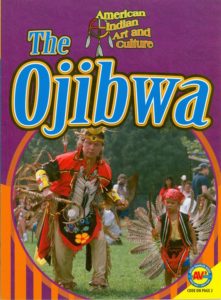Book review: The Ojibwa
Michelle Lomberg’s The Ojibwa is part of the American Indian Art and Culture series. This book has plenty of colour illustrations on bright glossy paper, with the vast majority drawn from contemporary sources. The Ojibwa consists of 13 sections, as well as a timeline, quiz, keywords, and an index. As an AV2 book, The Ojibwa comes with a unique code that will unlock multimedia content designed to enhance the educational experience as well as spark interest in exploring the topic further. The readership of this work is grade school up to about Grade 5.
The 13 sections consist of “People,” “Homes,” “Communities,” “Clothing,” “Food,” “Tools, Weapons and Defense,” “Religion,” “Ceremonies and Celebrations,” “Music and Dance,” “Language and Storytelling,” “Art,” “Creation,” and “Studying the Ojibwa’s Past.” Each section is about two pages in length. The majority of the sections have sidebars that detail information contained in the text. For instance, the sidebar associated with “Ojibwa Communities” provides information on “marriage and children” while the “Ojibwa Food” section’s sidebar has a tasty recipe for “Popped Wild Rice”.
Lomberg’s book is a well-done compilation of information for a grade school aged child. It emphasizes adaptability and continuance of culture. While some may disagree with the section heading “Ojibwa Religion”, Lomberg presents Anishinaabeg beliefs in a world inhabited by multiple spirits, the importance of the Midewiwin, and “vision quests”, which is accompanied by a sidebar that highlights our concepts of “animal rights” and offering prayers of thanks for “every animal or plant they took for food.” Although the author maintains that the Midewiwin was important since the 1700s, Anishinaabeg Elders argue it is far older.
The sections on “Ceremonies and Celebrations” and “Music and Dance” are used to deftly tie the past and present together in terms of spirituality and community. The use of modern images with explanations furthers this linkage. One section, “Ojibwa Creation,” seems out of place in the book. It deals with stories about the creation of the world and Nanabozho, the crane calling the clans together, and the introduction of the Clan System. The section’s sidebar includes information about the role of specific clans, such as the Hoof Clan being skilled at settling disputes and the Crane Clan being leaders. Nonetheless, the Creation Story section really should have appeared earlier in the work instead of being sandwiched between “Art” and “Studying the Ojibwa Past” all of which follows “Language and Story telling.” The final section on studying the past emphasizes the importance of oral history, archaeology, and the written record.
While this book is a decent grade school level introduction to the Ojibwa, it does appear to focus on the United States. The single map provided shows only reserves in Minnesota and the timeline only mentions treaties in the United States. The timeline also has a confusing tidbit where the Ojibwa are in Wisconsin between 6,000 – 3,000 B.C., but do not migrate from the Atlantic to the Great Lakes until 500 – 1620AD. A parent or teacher’s guidance (i.e., noting that treaties were also signed in Canada) can easily rectify these errors or shift from the U.S. focus.
The web-enhanced materials that are provided by AV2 are not the best. Most of the ‘enhancements’ consist of downloaded exercise sheets for teachers. A video aimed at explaining more about Ojibwa culture is a two-minute clip of powwow dancing without explanation. Two of the web links did not work; one was still bunder development and the other was ‘retired’. The slide show only provided images pulled from the book. While the exercise sheets may be of use to teachers, the ‘enhancements’ are useless for parents or children seeking to learn more. The enhanced media needs to be better thought out, constructed, and maintained.
Overall, despite the poorly developed ‘enhanced media,’ The Ojibwa is a good introduction for young children to learn something of the Anishinaabeg. It is a useful tool for parents and teachers, despite the lack of references to the Anishinaabeg experience in Canada. Specifically, the enhanced media, while of no interest to a child, the downloadable quizzes and guides are useful for teachers. Additionally, the timeline needs a mild corrective when talking about the book with your child or students.
Nevertheless, I would recommend this book as a starting point for any grade school aged children curious about the Ojibwa.
Michelle Lomberg, The Ojibwa, New York: AV2 by Weigl, 2016.



